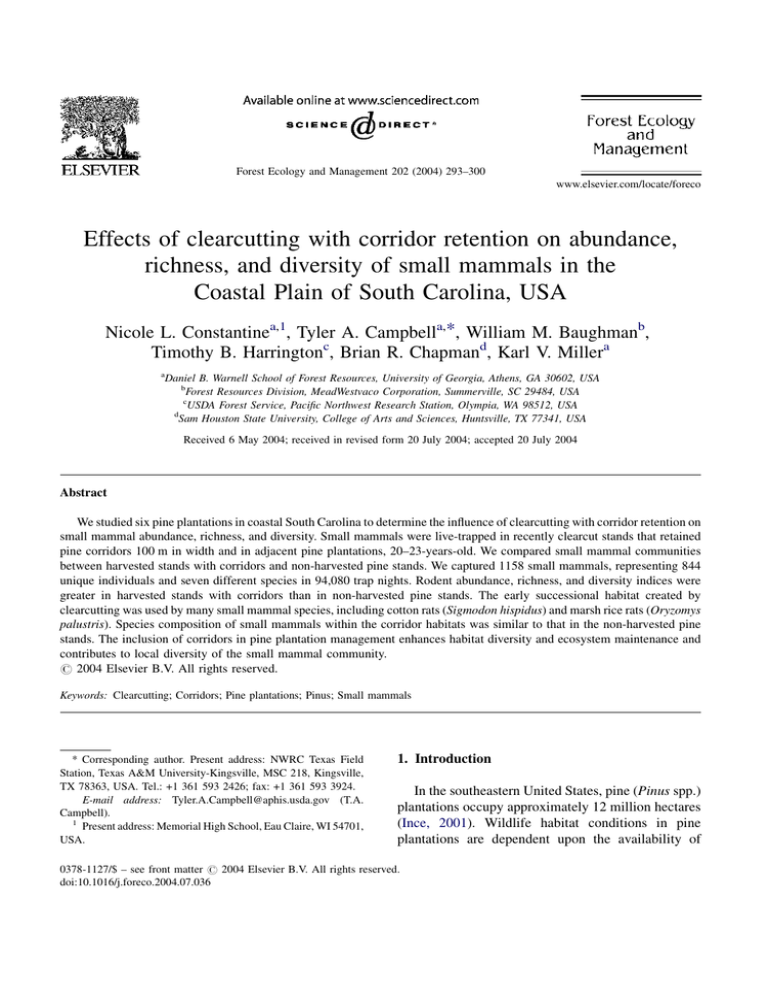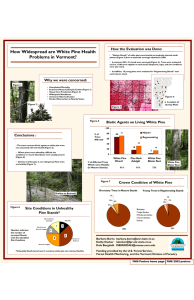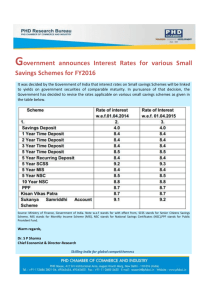
Forest Ecology and Management 202 (2004) 293–300
www.elsevier.com/locate/foreco
Effects of clearcutting with corridor retention on abundance,
richness, and diversity of small mammals in the
Coastal Plain of South Carolina, USA
Nicole L. Constantinea,1, Tyler A. Campbella,*, William M. Baughmanb,
Timothy B. Harringtonc, Brian R. Chapmand, Karl V. Millera
a
Daniel B. Warnell School of Forest Resources, University of Georgia, Athens, GA 30602, USA
b
Forest Resources Division, MeadWestvaco Corporation, Summerville, SC 29484, USA
c
USDA Forest Service, Pacific Northwest Research Station, Olympia, WA 98512, USA
d
Sam Houston State University, College of Arts and Sciences, Huntsville, TX 77341, USA
Received 6 May 2004; received in revised form 20 July 2004; accepted 20 July 2004
Abstract
We studied six pine plantations in coastal South Carolina to determine the influence of clearcutting with corridor retention on
small mammal abundance, richness, and diversity. Small mammals were live-trapped in recently clearcut stands that retained
pine corridors 100 m in width and in adjacent pine plantations, 20–23-years-old. We compared small mammal communities
between harvested stands with corridors and non-harvested pine stands. We captured 1158 small mammals, representing 844
unique individuals and seven different species in 94,080 trap nights. Rodent abundance, richness, and diversity indices were
greater in harvested stands with corridors than in non-harvested pine stands. The early successional habitat created by
clearcutting was used by many small mammal species, including cotton rats (Sigmodon hispidus) and marsh rice rats (Oryzomys
palustris). Species composition of small mammals within the corridor habitats was similar to that in the non-harvested pine
stands. The inclusion of corridors in pine plantation management enhances habitat diversity and ecosystem maintenance and
contributes to local diversity of the small mammal community.
# 2004 Elsevier B.V. All rights reserved.
Keywords: Clearcutting; Corridors; Pine plantations; Pinus; Small mammals
* Corresponding author. Present address: NWRC Texas Field
Station, Texas A&M University-Kingsville, MSC 218, Kingsville,
TX 78363, USA. Tel.: +1 361 593 2426; fax: +1 361 593 3924.
E-mail address: Tyler.A.Campbell@aphis.usda.gov (T.A.
Campbell).
1
Present address: Memorial High School, Eau Claire, WI 54701,
USA.
1. Introduction
In the southeastern United States, pine (Pinus spp.)
plantations occupy approximately 12 million hectares
(Ince, 2001). Wildlife habitat conditions in pine
plantations are dependent upon the availability of
0378-1127/$ – see front matter # 2004 Elsevier B.V. All rights reserved.
doi:10.1016/j.foreco.2004.07.036
294
N.L. Constantine et al. / Forest Ecology and Management 202 (2004) 293–300
associated plant resources (Huntly and Inouye, 1987).
Although young pine stands are used by a variety of
small mammal species (e.g., herbivores and grani­
vores), other species associated with later successional
habitat (e.g., insectivores) may occur in low abun­
dances.
Studies from various regions have examined the
influence of clearcutting on small mammal commu­
nities (Gashwiler, 1970; Kirkland, 1977, 1990; Pagels
et al., 1992; Steventon et al., 1998; Sullivan et al.,
1999). However, little attention has been given to
small mammal communities within pine plantations of
the southeastern United States, particularly in the
Lower Coastal Plain physiographic region. Most
studies conducted in the southeastern United States
have focused on the effects of various silvicultural
practices (e.g., thinning, herbicide application, and
site preparation) on small mammal communities
(Brooks, 1992; O’Connell and Miller, 1994; Rodrigue,
1994; Moore, 1996; Sparling, 1996; Johannsen, 1998).
Clearcutting causes substantial changes in small
mammal community structure (Kirkland, 1990).
Although the influence of clearcutting on small
mammal diversity and richness is unclear (studies
reviewed by Kirkland, 1990), the abundance of small
mammals tends to increase after timber harvest
(Trousdell, 1954; Umber and Harris, 1974; Kirkland,
1977).
Forest product companies often use short-rotation,
even-aged silvicultural systems to manage pine
plantations in the southeastern United States. How­
ever, because of environmental and societal concerns,
companies typically have multiple resource manage­
ment goals (e.g., timber, wildlife, water quality). The
use of streamside management zones (SMZs) are one
strategy commonly used in sustainable forestry
programs to meet multiple resource goals. Although
SMZs were designed to protect water systems from
potential impacts of silvicultural operations, they also
increase wildlife habitat diversity (Thurmond and
Miller, 1994). Based on this concept, the MeadWest­
vaco Corporation developed a strategy known as
Ecosystem-based Forestry to augment habitat hetero­
geneity for wildlife species. Employed at the land­
scape level, this program involves the overlap of a
mosaic of later successional habitats. These habitats
primarily include SMZs and special habitat zones.
However, where these features do not exist, 100-m
wide corridors of pines are retained in harvested stands
to maintain connectivity among late successional
stands. These retained corridors may serve as residual
habitat for small mammal species associated with
closed-canopy forests (e.g., insectivores), while the
adjacent harvested stands may provide habitat for
other species associated with early successional stages
(e.g., herbivores and granivores). Furthermore, retain­
ing corridors creates edge and ecotones between
harvested areas and forested corridors and may affect
small mammal species richness and diversity.
Although retained corridors may benefit wildlife
species, few studies have examined the ecological
value of corridor networks in pine forest ecosystems.
Our study provides basic information on the impact of
clearcutting and the importance of retained corridors
for the maintenance of small mammal communities
within managed pine forest ecosystems. We compared
small mammal communities (i.e., abundance, rich­
ness, and diversity) in three harvested stands with 100­
m wide retained corridors of pine and three nonharvested pine stands.
2. Methods
Our study was conducted in six intensivelymanaged loblolly pine (P. taeda) plantations (16–
20 ha, 20–23-years-old) within MeadWestvaco’s
South Region in the Lower Coastal Plain of South
Carolina. These plantations are productive with site
indices averaging 24.4 m for loblolly pine, base age 25
years. The average number of trees/ha for all sites was
672.5, the average basal area was 32.1 m2/ha, and the
average diameter at breast height was 27.9 cm.
Elevations range from 20 to 30 m above sea level.
All plantations were sheared, root raked, and bedded
upon establishment, but no additional management
practices were applied to the plantations thereafter.
Vegetation was dominated by loblolly pine with
scattered hardwoods, primarily sweetgum (Liquidam­
bar styraciflua) and red maple (Acer rubrum), in the
midstory. The understory vegetation was dominated
by wild grape (Vitis spp.), greenbrier (Smilax spp.),
poison ivy (Toxicodendron radicans), and Virginia
creeper (Parthenocissus quinquefolia).
We established rectangular small mammal trapping
grids that overlapped the proposed corridor and
N.L. Constantine et al. / Forest Ecology and Management 202 (2004) 293–300
Fig. 1. Design of the small mammal trapping grids within 16–20 ha
harvested pine stands with mature pine corridors (n =3) in the Lower
Coastal Plain of South Carolina. The numbers correspond to livetrap stations along transects (n = 8), with trap locations indicated
with black circle. Each of the 14 trap stations is 14.3 m apart. Similar
trapping grids were established within non-harvested pine stands
(n = 3).
adjacent proposed clearcut areas (Fig. 1). We paired
each harvested stand with an adjacent non-harvested
stand of intact pine forest and established similar
trapping grids. Within each grid we placed 14 trapping
stations at 14.3 m intervals along eight transects (n =
112 traps/grid). We placed one Sherman live-trap at
each trapping station. We baited traps with commer­
cial pellets (Flint River Mills, Bainbridge, Georgia,
USA) and set them for five consecutive nights during
each month. We trapped each grid pair simultaneously.
We surveyed small mammal populations within the
harvested and non-harvested stands during one preharvest (April 1998) and 27 post-harvest (June 1998–
August 2000) monthly sampling periods. We did not
sample in May 1998 because of ongoing timber
harvests. Upon capture, we identified each individual
to species, weighed it to the nearest gram, determined
sex and age class (adult, subadult, or juvenile),
uniquely marked it with a numbered monel ear tag,
and released it at the capture location. Additionally,
we recorded morphological measurements and recap­
ture status of each individual. All small mammal
capture and handling protocols were approved by the
University of Georgia’s Institutional Animal Care and
Use Committee (Permit No. A3437-01).
We grouped capture data from the 27 post-harvest
samples into nine, 3-month periods based on season
and duration since timber harvest. These periods were
June–August 1998 (1–3 months post-harvest), Sep­
tember–November 1998 (4–6 months post-harvest),
December 1998–February 1999 (7–9 months post­
295
harvest), March–May 1999 (10–12 months post­
harvest), June–August 1999 (13–15 months post­
harvest), September–November 1999 (16–18 months
post-harvest), December 1999–February 2000 (19–21
months post-harvest), March–May 2000 (22–24
months post-harvest), and June–August 2000 (25–
27 months post-harvest). We averaged relative abun­
dance, species richness, and species diversity of small
mammals for each 3-month period post-harvest and
during the 1 month pre-harvest. We based abundance,
richness, and diversity calculations on the captures of
unique individuals. We calculated capture rates (i.e.,
measure of relative abundance) as the number of small
mammals captured/100 trap nights, where a trap night
was one trap set over one night. We calculated species
richness for each trapping grid (i.e., 1.9 ha) based on
the number of species detected. We estimated species
diversity with the Shannon Index (Pielou, 1966)
because it gives preference to rare species (Krebs,
1966), and it is important to look at rare species in
studies concerned with changes in habitat (Sekgoror­
oane and Dilworth, 1995).
For our analyses, we used a randomized complete
block design with three replications of two treatments
(i.e., harvested stands with corridors and nonharvested stands). Harvested and non-harvested stands
were paired based on proximity and pre-harvest
characteristics (e.g., stand age, soil type). We used
stand pairings as our blocking factor. We did not
combine pre-harvest and post-harvest data because
combining data can mask a potential treatment effect
(Cody and Smith, 1991). We used 2-sample t tests to
compare capture rates, species richness, and species
diversity between the two treatments during the preharvest sampling period (i.e., April 1998). We used
repeated-measures ANOVA (split-plot in time) to
examine post-harvest data for treatment- (i.e.,
harvested stand with corridor or non-harvested stand,
the whole unit) and period- (i.e., months post-harvest,
the subunit) related differences in capture rates,
species richness, and species diversity (SAS Institute
Inc., 1990). Capture rate data for rodents (i.e.,
herbivores and granivores) and shrews (i.e., insecti­
vores) were analyzed separately. We used Tukey’s
Honestly Significant Difference (HSD) test to identify
post-harvest differences in small mammal commu­
nities between treatments and among periods. If the
repeated-measures ANOVA revealed a significant
296
N.L. Constantine et al. / Forest Ecology and Management 202 (2004) 293–300
treatment x period interaction, then we reassigned
unique designations for each level of treatment and
period, reanalyzed the data, and conducted multiple
comparisons with Tukey’s HSD test. The relevant
comparisons were treatment differences within a given
period and period differences within a given treatment.
For all tests, we accepted significance at a � 0.10, but
considered P � 0.15 to be biologically meaningful
(Tacha et al., 1982).
3. Results
During 94,080 trap nights, we recorded 1158
captures of 844 small mammals consisting of 503
rodents (60%) and 341 shrews (40%). Cotton mice
(Peromyscus gossypinus) and cotton rats were the
most commonly captured rodent species, representing
31 and 24% of all captures, respectively. Southern
short-tailed shrews (Blarina carolinensis) were the
most commonly captured shrew species, representing
32% of all captures. Eastern harvest mice (Reithro­
dontomys humulis) represented 12% of all captures.
Marsh rice rats, golden mice (Ochrotomys nuttalli),
and southeastern shrews (Sorex longirostrus), collec­
tively represented 1% of all captures.
Capture rates of rodents (t = 0.46, d.f. = 4, P = 0.67)
and shrews (t = 0.58, d.f. = 4, P = 0.60), species
richness (t = 0.90, d.f. = 4, P = 0.42), and species
diversity (t = 0.59, d.f. = 4, P = 0.59) did not differ
between the two treatments during pre-harvest
sampling. Preliminary analyses of post-harvest cap­
ture rates revealed a treatment x period interaction for
rodents (F = 3.01, d.f. = 8,16, P = 0.05). Therefore, we
tested for differences between treatments within each
period post-harvest (n = 9) and for differences among
period post-harvest within each treatment. Rodent
capture rates were greater (P � 0.10) in harvested
stands with corridors than in non-harvested stands
during several periods post-harvest (Table 1). In nonharvested stands, the capture rates of rodents did not
differ among periods post-harvest. However, in
harvested stands with corridors rodent capture rates
varied among periods following harvest (Table 1).
Because the model for post-harvest shrew capture
rates lacked significant interaction, treatment- and
period-related differences were examined. Shrew
capture rates did not differ (F = 0.45, d.f. = 1,2, P
= 0.57) between harvested stands with corridors and
non-harvested stands. However, shrew capture rates
declined (F = 35.61, d.f. = 8,16, P < 0.0001) with
period post-harvest (Table 1).
Table 1
Mean (±S.E.) relative abundance (captures/100 trap nights) of rodents and shrews in three harvested pine stands with corridors and three nonharvested pine stands in the Lower Coastal Plain of South Carolina, 1998–2000
Months post-harvest
Rodent relative abundancea,b
e
Harvested
Pre-harvest
1–3 (period
4–6 (period
7–9 (period
10–12 (period
13–15 (period
16–18 (period
19–21 (period
22–24 (period
25–27 (period
a
1)
2)
3)
4)
5)
6)
7)
8)
9)
1.19
1.51
0.72
1.81
3.23
2.82
0.97
0.70
1.12
2.21
(0.61)
(0.27)
(0.94)
(0.51)
(0.34)
(0.38)
(0.46)
(0.16)
(0.38)
(0.23)
BCDE
CDE
ABCD
A
AB
CDE
CDE
CDE
CDE
Shrew relative abundancec,d
Non-harvested
Treatment
difference
Harvestede
Non-harvested
Treatment
difference
0.94
0.12
0.08
0.18
0.28
0.66
0.11
0.07
0.05
0.09
–
0.20
1.12
0.83
0.63
0.20
0.03
0.06
0.11
0.05
0.17
0.45
1.55
0.76
0.48
0.02
0.07
0.02
0.00
0.02
0.02
–
A
AB
B
B
B
B
B
B
B
(0.49)
(0.06)
(0.03)
(0.26)
(0.25)
(0.06)
(0.11)
(0.13)
(0.09)
(0.12)
A
A
A
A
A
A
A
A
A
A
*
*
*
*
(0.28)
(0.66)
(0.70)
(0.65)
(0.05)
(0.03)
(0.01)
(0.04)
(0.08)
(0.11)
(0.53)
(0.41)
(0.4)
(0.52)
(0.03)
(0.08)
(0.03)
(0.00)
(0.04)
(0.04)
Significant treatment x period interaction (P � 0.05); means (±S.E.) within a given treatment column followed by the same letter are not
different (P � 0.10); asterisks indicate which means for a given period differ significantly between treatments (P � 0.10).
b
Rodents included golden mice, marsh rice rats, cotton mice, eastern harvest mice, and cotton rats.
c
Period effect (P < 0.0001); treatment x period means (±S.E.) are shown; periods followed by the same letter are not different (P � 0.10).
d
Shrews included southern short-tailed shrews and southeastern shrews.
e
With corridors.
N.L. Constantine et al. / Forest Ecology and Management 202 (2004) 293–300
297
Table 2
Mean (±S.E.) species richness (number of species captured/1.9 ha sample area) and species diversity (Shannon Index) of small mammals
(rodents and shrews combined) in three harvested pine stands with corridors and three non-harvested pine stands in the Lower Coastal Plain of
South Carolina, 1998–2000
Species richnessa,b
Months post-harvest
Pre-harvest
1–3 (period
4–6 (period
7–9 (period
10–12 (period
13–15 (period
16–18 (period
19–21 (period
22–24 (period
25–27 (period
a
b
c
1)
2)
3)
4)
5)
6)
7)
8)
9)
Species diversity
Harvestedc
Non-harvested
Period difference
Harvestedc
Non-harvested
1.67
2.78
2.67
3.22
3.44
2.67
1.56
1.78
1.89
2.45
2.67
1.22
1.33
0.78
0.89
1.55
0.67
0.33
0.22
0.67
–
AB
AB
AB
A
A
BC
C
C
ABC
0.31
0.68
0.72
0.83
0.90
0.61
0.33
0.50
0.59
0.72
0.57
0.09
0.19
0.05
0.17
0.32
0.12
0.00
0.22
0.07
(1.15)
(0.51)
(0.34)
(1.07)
(0.20)
(0.88)
(1.02)
(0.84)
(0.19)
(0.69)
(1.53)
(0.69)
(0.67)
(0.19)
(0.51)
(0.69)
(0.67)
(0.00)
(0.19)
(0.34)
(0.54)
(0.23)
(0.28)
(0.30)
(0.08)
(0.14)
(0.38)
(0.27)
(0.04)
(0.13)
(0.44)
(0.16)
(0.26)
(0.09)
(0.15)
(0.16)
(0.21)
(0.00)
(0.19)
(0.12)
Treatment effect (P � 0.02); harvested > non-harvested.
Period effect (P � 0.003); treatment x period means (±S.E.) are shown; periods followed by the same letter are not different (P � 0.10).
With corridors.
No significant treatment x period interaction
occurred with small mammal richness or diversity.
Species richness (i.e., number of species per grid) was
greater (F = 55.69, d.f. = 1,2, P = 0.02) in harvested
stands with corridors than in non-harvested stands and
differed (F = 5.16, d.f. = 8,16, P = 0.003) among
periods post-harvest (Table 2). Small mammal
diversity was greater (F = 51.01, d.f. = 1,2, P =
0.02) in harvested stands with corridors than in nonharvested stands, but did not differ (F = 1.82, d.f. =
8,16, P = 0.17) among periods post-harvest (Table 2).
Although eastern harvest mice were often captured
in harvested stands with corridors, cotton mice and
cotton rats were the most commonly captured rodents
in this habitat type. Clearcut habitats within the
harvested stands with corridors were the only habitat
type where marsh rice rats were found (Table 3).
Overall, cotton rats and cotton mice were most
common in clearcut habitats (Table 3). Eastern harvest
mice were more common in clearcut habitats than in
corridor habitats, although several eastern harvest
mice were captured at the interface between the
clearcut and corridor habitats. Southern short-tailed
shrews were the most commonly captured small
mammal in non-harvested stands and in the pine
corridors of harvested stands. Golden mice were
captured in non-harvested stands and within the pine
corridors of harvested stands, but not in adjacent
clearcut habitats (Table 3).
There were several significant (P < 0.10 or close
approximates P = 0.13) within-species differences in
capture rates between harvested and non-harvested
Table 3
Mean (±S.E.) relative abundance (captures/100 trap nights) of small mammals by species in three harvested pine stands with corridors (i.e.,
overall, clearcut areas, and corridors) and three non-harvested pine stands (i.e., forest) in the Lower Coastal Plain of South Carolina, 1998–2000
Habitat type
Speciesa
BLCA
Harvested standb
Clearcut
Corridor
Non-harvested stand
P valuec
0.13
0.09
0.20
0.13
0.98
OCNU
ORPA
(0.14) 0.003 (0.01) 0.003 (0.007)
(0.08)
0.007 (0.02)
(0.26) 0.002 (0.006)
(0.22) 0.004 (0.008)
0.62
PEGO
REHU
SIHI
0.13 (0.05)
0.17 (0.12)
0.04 (0.03)
0.02 (0.01)
0.0001
0.08 (0.12)
0.16 (0.26)
0.02 (0.03)
0.004 (0.009)
0.13
0.15 (0.09)
0.68 (0.26)
0.31 (0.19)
1.15 (0.55)
0.002 (0.02)
0.31 (0.28)
0.003 (0.007) 0.001 (0.003) 0.19 (0.20)
0.006
0.001
SOLO
ALL
a
BLCA: southern short-tailed shrews; OCNU: golden mice; ORPA: marsh rice rats; PEGO: cotton mice; REHU: eastern harvest mice; SIHI:
cotton rats; SOLO: southeastern shrews; ALL: all species combined.
b
Entire treatment area (i.e., both clearcut and corridor habitats combined) including edge captures.
c
P value of difference between harvested and non-harvested stands.
298
N.L. Constantine et al. / Forest Ecology and Management 202 (2004) 293–300
stands (Table 3). Capture rates of all small mammals
combined (t = 1.75, d.f. = 15, P = 0.001), cotton mice
(t = 5.22, d.f. = 15, P = 0.0001), eastern harvest mice (t
= 1.70, d.f. = 8, P = 0.13), and cotton rats (t = 3.72, d.f.
= 8, P = 0.006) were greater in harvested stands with
corridors than in non-harvested stands. Southern
short-tailed shrew and golden mice capture rates in
the harvested stands with corridors were similar (t =
0.02, d.f. = 14, P = 0.98; t = 0.51, d.f. = 10, P = 0.62,
respectively) to those of the non-harvested stands
(Table 3).
4. Discussion
Mosaic landscapes such as those created by
clearcutting with corridor retention may contribute
to habitat heterogeneity and ecosystem maintenance,
two critical components in sustainable resource
management (Franklin and Forman, 1987). Retaining
corridors of pine at harvest will increase habitat
diversity and perhaps maintain some small mammal
species that are characteristic of later successional
habitats while creating habitat for others that are
characteristic of early successional habitats.
Although insectivorous species, such as southern
short-tailed shrew, tend to exhibit a more temperate
response to timber harvest than granivorous and
herbivorous species (Kirkland, 1990), we found no
differences in shrew numbers between treatments,
suggesting that their numbers remained high follow­
ing harvest because of the retention of the pine
corridor. Additionally, we found no differences in
golden mice numbers between treatments. We only
captured golden mice, a semi-arboreal species that
generally inhabits forested areas (Linzey and Packard,
1977), in non-harvested stands and in pine corridors.
Thus, pine corridors may have served as refugia for
some forest dwelling, small mammal species.
Whereas corridors provided habitat for some forest
dwelling small mammals, recently clearcut areas
adjacent to these stands provided habitat for other
small mammal species. Consistent with the findings of
others (Perkins et al., 1988; Pagels et al., 1992), we
found greater rodent abundance, species richness, and
species diversity in harvested stands with corridors
than in non-harvested stands. The clearcut areas
within the harvested stands were invaded by small
mammals typical of early successional habitats.
Cotton rats, an edge/old-field species (Pagels et al.,
1992), tend to favor habitats with dense herbaceous
understory plants (Atkeson and Johnson, 1979;
Cameron and Spencer, 1981; Langley and Shure,
1980; Thurmond and Miller, 1994) and this species
occurred in greatest numbers in our recently clearcut
areas. Cotton mice, a species that uses clearcut
habitats more than corridor habitats (Bayne and
Hobson, 1998), were captured more often in recently
clearcut areas than in adjacent forest patches. Marsh
rice rats may have colonized recently clearcut areas
because of the standing water, which resulted from a
rise in the water table following clearcutting (Xu et al.,
1999).
The retention of corridors can increase the number
of niches available to wildlife by increasing the
amount of edge. Eastern harvest mouse captures were
highest in harvested stands with corridors and harvest
mice, an edge-specialist (Lidicker and Koening,
1996), prefers areas with dense grass (Thurmond
and Miller, 1994). Retention of corridors created an
ecotone that was favorable to harvest mice, which is
consistent with other findings (Mengak and Tipton,
1978).
Variation in rodent captures among periods
following harvest in harvested stands with corridors
may be a result of natural fluctuations. Periodic, cyclic
fluctuations in abundance of some small mammal
populations are common (Krebs, 1966). Furthermore,
cotton rats, one of the most commonly captured small
mammals in harvested stands with corridors, reach
peak abundance during the summer in the southeastern
United States (Odum, 1955), whereas cotton mice
abundance peaks during the winter (Wolfe and Linzey,
1977).
The decline in shrew numbers at 7–9 months post­
harvest (i.e., December 1998–February 1999) coin­
cides with the start of drought conditions at our study
sites (Southeast Regional Climate Center, 2000).
Rainfall for the period of December 1998 to February
1999 was 52.5 mm below normal (National Oceanic
and Atmospheric Administration, 1998; Southeast
Regional Climate Center, 2000). Furthermore, abun­
dance of southern short-tailed shrews in wooded
habitats is limited by the availability of food (George
et al., 1986) and insects, the primary food resource of
shrews, may have declined during dry periods.
N.L. Constantine et al. / Forest Ecology and Management 202 (2004) 293–300
Small mammal communities in pine plantations are
positively affected by clearcutting with corridor
retention. Relatively narrow corridors (e.g., 100 m)
of mature pine forest may maintain small mammals
that are characteristic of later successional habitats
(e.g., shrews and golden mice), while clearcutting
creates early successional habitat that is favored by
other small mammals (e.g., cotton rats). Inclusion of
corridors in pine plantation management enhances
habitat diversity and ecosystem maintenance and
thereby contributes to local diversity of the small
mammal community.
Acknowledgements
This research was supported by the MeadWestvaco
Corporation, McIntire-Stennis Project Number GEO­
0093-MS, and the Daniel B. Warnell School of Forest
Resources at the University of Georgia. We would like
to thank P.E. Hale, J.L. Anderson, and numerous
students from the University of Georgia who assisted
with data collection. Special thanks to D.A. Osborn,
J.P. Carroll, and C.J. Fonnesbeck for their editorial
comments or statistical advice.
References
Atkeson, T.D., Johnson, S.D., 1979. Succession of small mammals
on pine plantations in the Georgia Piedmont. Am. Midl. Nat.
101, 385–392.
Bayne, E.M., Hobson, K.A., 1998. The effects of habitat fragmenta­
tion by forestry and agriculture on the abundance of small
mammals in the southern boreal mixedwood forest. Can. J.
Zool. 76, 62–69.
Brooks, J.J., 1992. Chemical site preparation: effects on wildlife
habitat and small mammal populations in the Georgia Sandhills.
M.S. Thesis, University of Georgia, Athens, GA.
Cameron, G.N., Spencer, S.R., 1981. Sigmodon hispidus. Mamm.
Species 158, 1–9.
Cody, R.P., Smith, J.K., 1991. Applied Statistics and the SAS
Programming Language, 3rd ed. Prentice-Hall, Englewood
Cliffs, NJ, USA.
Franklin, J.F., Forman, R.T.T., 1987. Creating landscape patterns by
forest cutting: ecological consequences and principles. Land.
Ecol. 1, 5–18.
Gashwiler, J.S., 1970. Plant and mammal changes on a clearcut in
west-central Oregon. Ecology 51, 1018–1026.
George, S.B., Choate, J.R., Genoways, H.H., 1986. Blarina brevi­
cauda. Mamm. Species 261, 1–9.
299
Huntly, N., Inouye, R.S., 1987. Small mammal populations of an
old-field chronosequence: successional patterns and associations
with vegetation. J. Mamm. 68, 739–745.
Ince, P.J., 2001. Outlook for sustainable fiber supply through forest
management and other developments in the U.S. pulp and paper
sector. In: Proceedings of International Environment Health
Safety Conference and Exhibit, Charlotte, NC.
Johannsen, K.L., 1998. Effects of thinning and herbicide application
on vertebrate communities in young longleaf pine plantations.
M.S. Thesis, University of Georgia, Athens, GA.
Kirkland Jr., G.L., 1977. Responses of small mammals to the
clearcutting of northern Appalachian forests. J. Mamm. 58,
600–609.
Kirkland Jr., G.L., 1990. Patterns of initial small mammal commu­
nity change after clearcutting of temperate North American
forests. Oikos 59, 313–320.
Krebs, C.J., 1966. Demographic changes in fluctuating populations
of Microtus californicus. Ecol. Monogr. 36, 239–273.
Langley Jr., A.K., Shure, D.J., 1980. The effects of loblolly pine
plantations on small mammal populations. Am. Midl. Nat. 103,
59–65.
Lidicker Jr., W.Z., Koening, W.D., 1996. Responses of terrestrial
vertebrates to habitat edges and corridors. In: McCullough, D.R.
(Ed.), Metapopulation and Wildlife Conservation. Island Press,
Washington, DC, pp. 85–109.
Linzey, D.W., Packard, R.L., 1977. Ochrotomys nuttalli. Mamm.
Species 75, 1–6.
Mengak, M.T., Tipton, A.R., 1978. Comparison of small mammal
occurrence in one and four year old pine plantations. Va. J. Sci.
29, 65.
Moore, W.F., 1996. Effects of chemical site preparation on vege­
tative, small mammal, and songbird communities in the Georgia
Sandhills. M.S. Thesis, University of Georgia, Athens, GA.
National Oceanic and Atmospheric Administration, 1998. Clima­
tological data, station daily maximum and minimum tempera­
tures and precipitation: South Carolina. U.S. Department of
Commerce, National Climatic Data Center, Asheville, NC.
O’Connell, W.E., Miller, K.V., 1994. Site preparation influences on
vegetative composition and avian and small mammal commu­
nities in the South Carolina Upper Coastal Plain. Proc. Annu.
Conf. Southeast Assoc. Fish Wildl. Agencies 48, 321–330.
Odum, E.P., 1955. An eleven year history of a Sigmodon population.
Ibid. 36, 368–378.
Pagels, J.P., Erdle, S.Y., Uthus, K.L., 1992. Small mammal diversity
in forested and clearcut habitats in the Virginia Piedmont. Va. J.
Sci. 43, 171–176.
Perkins, C.J., Hurst, G.A., Roach, E.R., 1988. Relative abundance of
small mammals in young pine plantations.. Proc. South. Silvi.
Res. Conf., Memphis, TN.
Pielou, E.C., 1966. The measurement of diversity in different types
of biological collections. J. Theor. Biol. 13, 131–144.
Rodrigue, J.L., 1994. The effects of chemical site preparation on
diversity and composition of forest vegetation and small mam­
mal communities. M.S. Thesis, University of Georgia, Athens,
GA.
SAS Institute Inc., 1990. SAT/STAT User’s Guide: Statistics,
Version 6, 4th ed., vol. 2. SAS Institute, Inc., Cary, NC.
300
N.L. Constantine et al. / Forest Ecology and Management 202 (2004) 293–300
Sekgororoane, G.B., Dilworth, T.G., 1995. Relative abundance,
richness, and diversity of small mammals at induced forest
edges. Can. J. Zool. 73, 1432–1437.
Southeast Regional Climate Center, 2000. South Carolina Dept.
Natural Resources, Water Resources Division. Southeast Regio­
nal Climate Center, Columbia, SC.
Sparling, V.A., 1996. Effects of chemical and mechanical site
preparation on the habitat and abundance of birds and small
mammals in the Upper Coastal Plain of South Carolina. M.S.
Thesis, University of Georgia, Athens, GA.
Steventon, J.D., Mackenzie, K.L., Mahon, T.E., 1998. Response
of small mammals and birds to partial cutting and clearcutting
in northwest British Columbia. For. Chron. 74, 105–109.
Sullivan, T.P., Lautenschlager, R.A., Wagner, R.G., 1999. Clearcutting and burning of northern spruce-fir forests: implica­
tions for small mammal communities. J. Appl. Ecol. 36,
336–348.
Tacha, T.C., Warde, W.D., Burnham, K.P., 1982. Use and inter­
pretation of statistics in wildlife journals. Wildl. Soc. Bull. 10,
355–362.
Thurmond, D.P., Miller, K.V., 1994. Small mammal communities in
streamside management zones. Brimleyana 21, 125–130.
Trousdell, K.B., 1954. Peak population of seed-eating rodents and
shrews occurs one year after loblolly stands are cut. USDA For.
Serv., S. For. Exp. Station Res. Note 68 .
Umber, R.W., Harris, L.D., 1974. Effects of intensive forestry on
succession and wildlife in Florida sandhills. Proc. Annu. Conf.
Southeast Assoc. Game Fish Comm. 686–693.
Wolfe, J.L., Linzey, A.V., 1977. Peromyscus gossypinus. Mamm.
Species 70, 1–5.
Xu, Y.J., Aust, W.M., Burger, J.A., Patterson, S.C., Miwa, M., 1999.
Recovery of hydroperiod after timber harvesting in forested
wetlands. Proc. Bienn. South. Silvic. Conf. USDA For. Serv.,
Gen. Tech. Re SRS-30.






